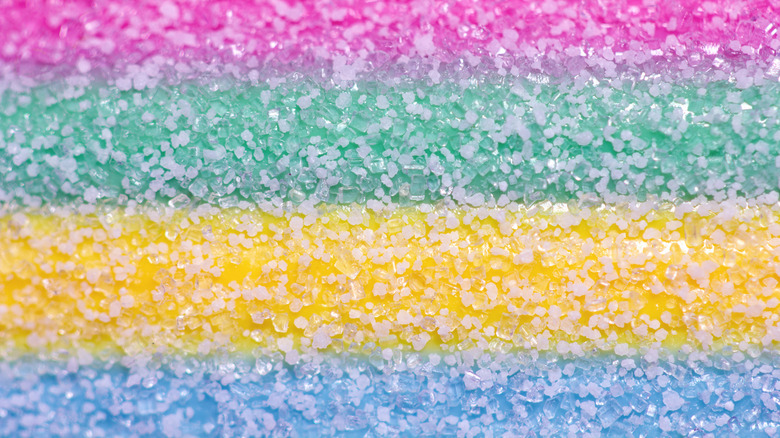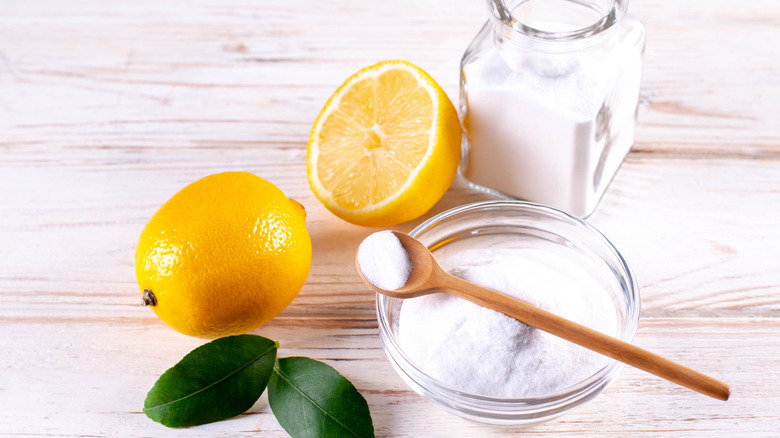What Makes Sour Candy Sour?
There is a profound line in the play "Henry VI: Part 3" by William Shakespeare in which the beleaguered king says, "Let me embrace thee, sour candy, for wise men say it is the wisest course." Alright, fine, we're warping the bard's words a little bit there. The actual line refers to "sour adversity," but we think our rendition imparts even greater wisdom. Indeed, for those who love sour flavors, there can be no wiser choice. There are many for whom the taste for sour candy transcends descriptors such as "like" and "love," reaching a point that can only be described as a candy obsession. Even when it feels like the skin of your tongue is about to peel clean off, it's hard to stop eating sour candy. It's the quintessential example of "hurts so good."
If these words apply to you, you're in good company. This is doubly true if you live in Illinois, Maine, Massachusetts, Nebraska, or New York, where Sour Patch Kids stole the top spot in our ranking of the most popular Halloween candy in each state, per CandyStore.com. Louisiana also deserves a special shoutout for its love of Lemonheads, too often underrated among sour treats. Whether or not you like the taste, you may have wondered at some point what makes sour candy sour. For the most part, it comes down to one basic (or rather, acidic) ingredient.
The source of sour
One visual feature that most sour candies have in common is a coating of white powder. One of the greatest joys for sour candy lovers is getting to the bottom of the bag and finding a stockpile of excess powder that you can dump straight into your mouth for one final hit of that sour, sour goodness. As you've probably suspected, this powder is the key to sour candy's flavor, and pastry chef Paola Velez told Food & Wine that it's really citric acid, the same compound that lends a tangy taste to lemons and limes. Citric acid is not exclusive to citrus though, as Healthline reveals that nearly every tart fruit, including raspberries, pineapple, and cherries draws flavor from it. You'll even find citric acid in tomatoes.
The citric acid used to make sour candy rarely comes directly from fruits, as extracting it is a very costly process. Plus, according to Whole Food Earth, the demand for citric acid exceeds the world's supply of citrus. Fortunately, there's another way to produce citric acid: microbial fermentation. It begins by feeding sugar to a type of fungus called Aspergillus, which is commonly used in pharmaceuticals. Over time, the fungus ferments, much like yeast ferments in beer, producing citric acid. Other types of acid may also show up in your candy. For instance, WIRED reports that the super-sour nature of Warheads comes from a combination of citric acid, malic acid (found in apples), and ascorbic acid (vitamin C).
Other uses for citric acid
Citric acid is a versatile ingredient, and while it is best known as a sour flavor agent, it has many other uses as well. Paola Velez tells Food & Wine that she uses small amounts of citric acid in desserts like custard and vanilla wafers to ensure that the sweetness does not become overpowering. It can also be used to enhance the flavor of ingredients that already have some tartness to them, a useful feature when you're making desserts with a major fruit component. Another good tip comes from Epicurious, which suggests using citric acid powder in place of lemon juice or vinegar when you want to add a tart kick to your food without compromising the texture by adding a liquid element.
As much as we love sourness, the most important uses of citric acid have nothing to do with the way it tastes. ScienceDirect reveals that citric acid has notable antioxidative effects. It has been used to some degree in medicine, but this feature is also significant from a cooking standpoint. Food & Wine points out that citric acid is very useful for preserving food because it inhibits bacteria from growing. This fact, coupled with its tartness, is why you often find citric acid in jam. It can also be used to preserve the natural color of some foods. Epicurious notes that many fruits, avocados being a notable example, turn brown as they oxidize, but citric acid can prevent this.


